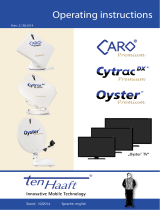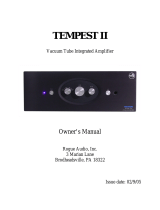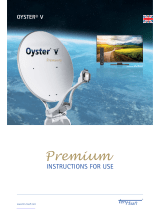Anthem TEMPEST II Product Review
- Category
- Audio amplifiers
- Type
- Product Review
This manual is also suitable for

REVIEW
P R O D U C T
TLP 1 • PVA 2
WARNING: ANTHEM GEAR
“
MAY BE ADDICTIVE.
”
I’ve always used integrated ampli ers—
not only because I then needed to buy one
less interconnect, but because they also
save space, which was always at a premi-
um in my New York City apartment. Now
that I’ve made the move from city slicker to
suburban dad, I’ve got space to spare and
can nally explore separates.
The TLP 1 preampli er-tuner and PVA 2
two-channel power ampli er are the entry-
level models in Anthem’s line. The TLP 1
shares the good looks of Anthem’s AVM 20
multichannel preamp-processor-tuner, but
its features have been scaled down for
a two-channel system. The PVA 2 is the
125Wpc stereo sibling of the ve-channel
PVA 5 and seven-channel PVA 7 ampli-
ers. But don’t mistake “entry-level” with
compromised value, quality, or sound. The
TLP 1 and PVA 2 delivered the goods in a
way that belied their sensible pricing.
FEATURES AND SETUP
The TLP 1 and PVA 2’s beautiful brushed-
silver enclosures make them a pretty stylish
couple. The TLP 1 comes with a simple
FM/AM antenna and a universal remote
from which you can control all of its fea-
tures, as well as those of your DVD player,
VCR, or satellite box. While the PVA 2 is
pretty straightforward, the TLP 1 has sev-
eral features that greatly increase its value
as a tuner and preamp.
The front of the TLP 1 has a large control
knob, a small display, a headphone jack,
and several small buttons that control all
of the preamp-tuner’s functions. The dis-
play usually shows which source, volume
setting, and station frequency have been
selected. The front-panel buttons are ar-
ranged logically, although having larger
buttons for the functions used most often
would have been helpful.
Starting on the TLP 1’s left side, there are
rows of three buttons each for input selec-
tion, and a seventh for selecting the record-
ing path. The input buttons’ labels—which
include DVD, VCR, and Aux-Sat—indicate
that Anthem expects the TLP 1 to be used
in an audio/video system.
The next item to the left is the headphone
jack, which provided adequate power for my
Grado SR60s. This is followed by the display,
and under it, two rows of buttons. The rst
row includes the tuner’s station presets and
seek function. The second row begins with
TLP 1
PVA 2
B Y E R I C H E T H E R I N G T O N

TLP 1 • PVA 2
TLP 1 • PVA 2
one button for balance and display brightness, three tone controls,
and ends with the Mute and Contour buttons. At the end of the dis-
play are two buttons for tuning the radio, and last is a large control
knob, which can be used to change volume, tune the radio, and
set adjustments.
“ The TLP 1 and PVA 2 are the entry-level
models in Anthem’s line … But don’t
mistake “entry-level” with compromised
value, quality, or sound. The TLP 1 and PVA 2
delivered the goods in a way that belied their
sensible pricing.”
The TLP 1’s tone and volume controls are rather sophisticated.
You can set the treble and bass for each of the six inputs and the
TLP 1 will remember them. This is convenient, particularly if one
source (a cheap VCR, perhaps) needs more tone-control help than
the others. The Contour function helps set the tone controls for
low-level listening: You’ve probably noticed that when you listen
at lower levels, you’re less able to hear certain frequencies. This
isn’t necessarily a problem with your hearing, it’s just how the
human
ear works. The TLP 1’s Contour feature sets the treble and
bass to
compensate for this natural hearing loss, and makes low-
level listening more like what you hear at higher volumes. Purists
can defeat the tone controls so that the input signals bypass them.
You can also set different volume levels for all of your sources, so
you don’t have to worry about volume uctuations as you preview
different sources.
The TLP 1’s rear panel is almost as full of features as the front.
There are two 3.5mm mini-jack inputs (one for a relay trigger,
one for an infrared input), ve inputs, two line-level outputs (for
recording or sending the signal to a second speaker zone), two sub-
woofer outputs (one full-range, one low-pass), and two outputs for
the power ampli er (one full-range, one high-pass). Dual outputs
for the subwoofer and ampli er means that the preamp is ready to
be used with full-range speakers, with or without a subwoofer—or
with smaller satellite speakers accompanied by a sub. If you can
use your subwoofer to set a crossover level, then send it the full-
range signal; if not, use the TLP 1’s low-pass output.
The PVA 2 has a single green LED on the bottom center of its face-
plate and a power button on the lower right. It’s attractive as power
amps go, but if you nd an out-of-the-way place for it, you won’t
miss it. Anthem says to make sure there’s at least 12˝ of space
above the PVA 2 for proper heat dissipation, but I had it running
for hours at a time and it never got warm. The amp’s rear panel has
left and right inputs, two speaker binding posts, and a receptacle
for a power cord. One thing to note about the binding posts is that
while they’re obviously of high quality, their positive and negative
terminals were too far apart for the speaker cables I’ve been using,
which are terminated with dual banana plugs.
There’s also a switch to select between Manual turn-on (requires
you to turn the amp on from its face), Auto (the amp automatically
detects when a signal is present), and Trigger (you can connect
the amp to a preamp via a 3.5mm mini-jack, which will trigger the
amp to turn on when the preamp is turned on). If you use the Auto
or Trigger settings, the LED on the faceplate will glow red when the
amp is in standby mode, green when it’s operating.
Setting up the TLP 1 and PVA 2 was a breeze: I paired the combo
with Axiom M3ti and Quad 21L speakers, the Sony SCE-775 SACD
player, a Pro-Ject 1.2 turntable with Oyster cartridge, and a Rotel
RCD-1070 CD player. Add a pair of Analysis Plus Solo Crystal Oval
interconnects and Kimber speaker cables, and I was ready to go!
“… the TLP 1 and PVA 2 sounded better than
my receiver by a long shot. Dialogue, sound
effects, and lm scores were much less
congested … there was much more air around
all of the competing sounds … I could hear
many more distinct gun, bullet, and shell sound
effects … an excellent two-channel home
theater alternative.”
TRIAL
The TLP 1’s tuner section was much better than the tuner in my
Harman
Kardon AVR-100 home-theater receiver, pulling in more
stations clearly and sounding much better. The HK sounded shrill
and anemic by comparison. I could get more FM stations on my
Rotel RA-02 tuner, and it picked up AM signals better, but the dif-
ference was slight. Radio geeks might care that the Anthem lacks
RDS, but that won’t be a sticking point for most. (When I rst got
the Rotel, I had fun checking various stations’ text messages with
RDS, but that quickly wore off.) The Rotel’s richer sound made in-
struments and voices sound fuller, but if you, like most people, use
your radio for casual music listening or talk shows, then the TLP 1
should serve you well.
“… the Anthem’s crisp presentation allowed
me to hear each distinct voice as they inter-
weave through the piece … I could place the
voices in different locations … fast and dry …
very enjoyable sound … sharply detailed and
focused … a fast, clean, clear presentation of
whatever I threw at them.”
I tried the TLP 1 with both music and movies. I usually send all au-
dio signals from my DVD player to my receiver via a digital connec-
tion, so I took out a spare pair of interconnects and connected the
analog outputs to the TLP 1. While I preferred the 5.1-channel mix
to the Anthems’ two-channel presentation, the TLP 1 and PVA 2
sounded better than my receiver by a long shot. Dialogue, sound
effects, and lm scores were much less congested, and there was
much more air around all of the competing sounds than with the
Harman Kardon. I sampled
The Matrix
next. As I watched Neo and
Trinity enter the building to save Morpheus (chapter 29, “Lobby
Shooting Spree”), I could hear many more distinct gun, bullet, and
shell sound effects than with my receiver. If you don’t have room or
don’t want the hassle of six or more channels, the TLP 1 and PVA 2
make an excellent two-channel home-theater alternative.
2

TLP 1 • PVA 2
TLP 1 • PVA 2
When I listened to the Tallis Scholars’ rendition of Thomas Tallis’s
Spem in Alium
[CD, Gimell CDGIM 006], the Anthems’ crisp pre-
sentation allowed me to hear each distinct voice as they interweave
throughout the piece. The Anthems did a good job in the imaging
department as well, though the images were slightly at: I could
place the voices in different locations, but they seemed to all be the
same distance from me. When I played more contemporary music,
such as Erin McKeown’s ne new
Grand
[CD, nettwerk 30307 2], the
Grand [CD, nettwerk 30307 2], the Grand
Anthems seemed fast and dry—overall, a very enjoyable sound,
but, as with the Tallis piece, there was a lack of real three-dimen-
sional heft. The baritone sax on McKeown’s “The Taste of You,” for
example, didn’t seem to be the right size.
Overall, the Anthems gave a fast, clean, clear presentation of
whatever I threw at them. For their price and intended audience—
someone wanting a exible two-channel audio/video system—the
Anthems are hard to beat.
“… the TLP 1 will deliver everything you could
possibly need to tailor your system just the
way you want it and the PVA 2 will give you
all the power you could possibly want …
stylish … sophisticated … could be the heart
of your audio/video system for a long time …
the Anthems are hard to beat!”
COMPARISON
Along with my Harman Kardon home-theater receiver, which the
Anthems crushed handily, I had the Rotel RA-02 and the Rogue
Audio Tempest integrated ampli ers. For its price, the Rotel is a
good buy, but it was easy to hear that spending the extra money for
the Anthem combo would not be in vain. The Rotel has no tuner,
lacks the TLP 1’s sophisticated volume and tone controls, and the
Anthems offered more resolution and crisper sound.
The Rogue Audio Tempest had a much fuller, warmer sound, and
was able to more convincingly project a three-dimensional sound-
stage. However, the Rogue costs almost $1000 more than the An-
them combo, it has no tuner, and it’s really a minimalist’s machine:
no tone controls or fancy volume-control settings, and a remote
with only two buttons: volume up and volume down.
The Anthem products, on the other hand, can take on many more
tasks: They let you tailor the sound with tone controls, listen to
the radio, control your whole system from the remote, and listen
through headphones. For most people, the Anthems’ good sound
and array of features will come up the winner.
CONCLUSION
This Anthem TLP 1 and PVA 2 could be the heart of your audio/
video system for a long time. They provided a sharply detailed
and focused presentation of whatever I sent to them, faltering only
when compared to a product costing much more. With all its fea-
tures, the TLP 1 will deliver everything you could possibly need to
tailor your system just the way you want it, and the PVA 2 will give
you all the power you could reasonably want. The sound is enjoy-
able with music or movies.
If you want a two-channel audio/video system, check out the
Anthems. Ever since I sat down to listen to them, I’ve been eye-
ing Anthem’s AVM 20 and PVA 5 for my home theater. Warning:
Anthem gear may be addictive.
3
-
 1
1
-
 2
2
-
 3
3
Anthem TEMPEST II Product Review
- Category
- Audio amplifiers
- Type
- Product Review
- This manual is also suitable for
Ask a question and I''ll find the answer in the document
Finding information in a document is now easier with AI
Related papers
-
Anthem AVM 20 Operating instructions
-
Anthem AVM 30-HD User manual
-
Anthem AVM 2 User manual
-
Anthem STR Integrated Amplifier User manual
-
Anthem PVA 7 Operating instructions
-
Anthem STR Integrated Amplifier User manual
-
Anthem DJ Flat Par QA12 Product Review
-
Anthem TLP 1 User manual
-
Anthem PVA 2 Specification
-
Anthem MRX 540 8K User guide
Other documents
-
 Rogue Audio Tempest Owner's manual
Rogue Audio Tempest Owner's manual
-
Rotel RA-1070 User manual
-
Rotel RA-1070 Owner's manual
-
 Oyster Caro plus Premium Owner's manual
Oyster Caro plus Premium Owner's manual
-
Rotel RB-1070 User manual
-
Pulsar DSOS24VPU Operating instructions
-
Rotel RC-1070 User manual
-
 Energy Speaker Systems indoor / outdoor loudspeaker User manual
Energy Speaker Systems indoor / outdoor loudspeaker User manual
-
 Rogue Audio Tempest Vacuum Tube Integrated Amplifier User manual
Rogue Audio Tempest Vacuum Tube Integrated Amplifier User manual
-
 Ten-Haaft OYSTER V PREMIUM Instructions For Use Manual
Ten-Haaft OYSTER V PREMIUM Instructions For Use Manual







